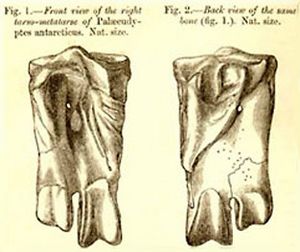Palaeeudyptes facts for kids
Palaeeudyptes (say "Pal-ee-yoo-DIP-tees") is a group of giant, ancient penguins that are now extinct (meaning they no longer exist). These amazing birds lived a very long time ago, between about 34 and 50 million years ago!
Quick facts for kids Palaeeudyptes |
|
|---|---|
 |
|
| Huxley’s original illustration of the fossil of an ankle bone from Palaeeudyptes antarcticus described in 1859. | |
| Scientific classification |
|
| Kingdom: | Animalia |
| Phylum: | Chordata |
| Class: | Aves |
| Order: | Sphenisciformes |
| Family: | Spheniscidae |
| Subfamily: | †Palaeeudyptinae |
| Genus: | †Palaeeudyptes Huxley, 1859 |
| Type species | |
| Palaeeudyptes antarcticus Huxley, 1859
|
|
| Species | |
|
Palaeeudyptes antarcticus |
|
| Synonyms | |
|
Eosphaeniscus Wiman, 1905 |
|
These ancient penguins were much bigger than most penguins alive today. Even the smaller Palaeeudyptes species were about the same size as a modern emperor penguin. The largest ones could stand up to 2 metres (about 6.5 feet) tall! Imagine a penguin taller than most grown-ups!
Contents
Where Did These Giant Penguins Live?
Scientists have found fossils of Palaeeudyptes in different parts of the world, mainly in the Southern Hemisphere.
Antarctica Discoveries
Two of the four known species, P. gunnari and P. klekowskii, have been found in Antarctica. Their fossils were discovered in rocks from the Middle or Late Eocene period, which was about 34 to 50 million years ago. These fossils were found on Seymour Island, which is off the coast of the Antarctic Peninsula.
New Zealand Finds
Another species, P. antarcticus, was the very first fossil penguin ever described by scientists! It was found in New Zealand in rocks from the Late Oligocene period (about 23 to 28 million years ago). This species is mostly known from a single ankle bone, but other bones have been found that might belong to it.
The fourth species, P. marplesi, was also found in New Zealand. Its fossils, mainly leg bones, come from rocks that are about 34 to 40 million years old. Scientists are still studying some of the New Zealand fossils because they are a mix of sizes, making it tricky to tell which species they belong to. It's possible that P. marplesi might have slowly evolved into the smaller P. antarcticus over time.
Other Locations
Fossils that belong to the Palaeeudyptes group have also been found in other places:
- In Australia, scientists found parts of a leg bone and an arm bone in rocks from the Late Eocene period near Adelaide.
- In southern Chile, an arm bone identified as Palaeeudyptes was found in rocks from the Middle to Late Eocene period.
What Do We Know About Their Bodies?
Scientists study the bones of these ancient penguins to learn about them. The group Palaeeudyptes is so important that a whole group of early penguins, called Palaeeudyptinae, is named after them!
Their bones show that they were not as advanced as some other ancient penguins, like the slightly smaller Archaeospheniscus. However, they were similar in bone structure to the super-giant penguin Anthropornis. Scientists are still working to understand exactly how Palaeeudyptes and its relatives are connected to the penguins we see waddling around today.
A Confusing Name?
There was once a supposed group of penguins called Wimanornis. However, scientists later realized that the fossils used to describe Wimanornis were actually just bones from P. gunnari. So, Wimanornis is now considered a synonym (another name for the same thing) of P. gunnari.
See also
 In Spanish: Palaeeudyptes para niños
In Spanish: Palaeeudyptes para niños

